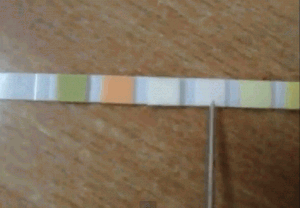A urinalysis is a urine test or an analysis of a urine sample. It provides results about various parameters noted in the urine test. One of these parameters is detection of nitrates in urine. In a majority of the cases, doctors check for nitrite content instead of nitrates in urine, as most urine sample have some amounts of nitrates in them.
The results of a urine test in healthy people will report the nitrite parameter as “absent” or “not present”. However, people with various conditions and infections of the urinary tract may elicit a “+” or “present” option for the nitrite parameter. In these cases, a physician may ask for another fresh urine sample to undergo further verification and urine evaluation.
In a majority of instances, nitrites in urine generally points to the occurrence of a specific type of bacteria which has the capacity to turn non ionic nitrate into nitrites. Hence, the detection of nitrites in urine is a possible indication of the occurrence of bacteria in a urine sample, which in turn signifies a possible infection of the urinary tract. The pathogens that result in urinary tract infections may differ and consist of various kinds of species like klebsiella, Pseudomonas, E. coli and Proteus Sp., etc. It is essential to note that bacteria and other types of pathogens that cause the conversion of nitrates in urine to nitrites are mostly of the gram-negative type.
Gross hematuria or blood in urine that is visible to the naked eye, and results in the development of pinkish, reddish or cola-colored urine can also possible lead to the occurrence of nitrites in urine. This visible change in urine appearance can be considered as one of the easiest methods to determine a problem of the urinary tract, which can be further verified via a urine test that indicates the presence of nitrites/nitrates in urine.
It is important to take into consideration a few vital things while interpreting a urine sample test results. A possible misunderstanding of the urine test results may occur when there is vaginal contamination of the urine sample, or when the dipstick used to check for the occurrence of nitrites/nitrates in urine, makes contact with atmospheric air. This can lead to false positive values for the occurrence of nitrites/nitrates in urine. In other instances, the presence of phenazopyridine, a kind of chemical used as an analgesic, in the urine sample can also give false positive values for nitrites/nitrates in urine.
In some cases, involving excess uribilinogen levels in urine; specific gravity; and urinary tract infection with bacteria that do not have capability to turn nitrates into nitrites, the urine sample test may show false negative values for nitrites/nitrates in urine. Also, the sample of urine may test false negative when the levels of pH in urine is less than six, and if the patient is regularly taking a diet that does not contain nitrates
In the above listed instances as well as in other cases, it is necessary to carry out more tests for better verification and examination. The lack of nitrites/nitrates in urine does not eliminate a possible infection of the urinary tract.

Nitrates in Urine – Symptoms
The signs and symptoms of nitrites/nitrates in urine are as follows:
- Problematic outflow of urine
- Discoloration of urine
- Smelly urine
- Burning sensations while urinating
- Vomiting and nausea
- Fever
Causes of nitrates in urine
- Nitrites/nitrates in urine refer to a byproduct formed due to the action of bacteria occurring in the urinary tract. The kidneys perform the vital function of cleaning the blood by filtering out the unnecessary, toxic matter from blood. The nitrite developed by bacteria cannot be filtered by the kidneys. However, they get passed out along with urine into the bladder. The presence of these nitrites is usually a positive indicative of bacterial infection of the urinary tract.
- The bacteria generally tend to enter the urinary tract via the urethra or from the bloodstream. Once, they have gained entry into the urinary tract, the bacteria multiply rapidly leading to the development of a urinary tract infection. The occurrence of both nitrites/nitrates in urine and leukocytes in urine is one of the best symptoms of a urinary tract infection.
- The urethral tube in women in shorter as compared to men. Also, the distance between the vagina, the anus and the urethral duct is comparatively smaller. Therefore, more are at an increased risk to developing urinary tract infections and nitrites/nitrates in urine as opposed to the opposite sex.
- People using a bladder catheter are also at increased vulnerability to developing a UTI or nitrites/nitrates in urine.
Nitrates in urine – treatment
- Most cases of urinary tract infections are treated with antibiotics
- The different instances of urinary tract infections and nitrites/nitrates in urine that are caused due to the occurrence of certain underlying diseases are treated as per the distinct cases.